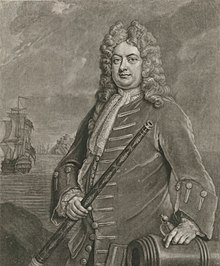Sir Thomas Hardy | |
|---|---|
 | |
| Born | 13 September 1666 Jersey |
| Died | 16 August 1732 |
| Buried | |
| Allegiance | Kingdom of Great Britain |
| Service/ | Royal Navy |
| Years of service | 1688–1716 |
| Rank | Rear-Admiral |
| Commands held | HMS Charles HMS Swallow Prize HMS Pendennis HMS Deal Castle HMS Coventry HMS Pembroke HMS Bedford HMS Kent HMS Albemarle HMS Royal Sovereign HMS Russell The Nore |
| Battles/wars | |
| Awards | Knight bachelor |
| Spouse(s) | Constance Hook |
| Relations | Sir Charles Hardy (cousin) |
| Other work | High Sheriff of Dorset MP for Weymouth and Melcombe Regis Master of Trinity House |
Rear-Admiral Sir Thomas Hardy (13 September 1666 – 16 August 1732) was a Royal Navy officer of the late 17th and early 18th centuries. Having joined the navy sometime before 1688, Hardy's career was supported by Captain George Churchill, whom he served as first lieutenant during the Battle of Barfleur in 1692. Promoted to captain in 1693, Hardy served in the Channel Islands and off the coast of England until 1702 when he was given command of HMS Pembroke off the coast of Spain. He fought at the Battle of Cádiz, and subsequently discovered the location of the Franco-Spanish fleet through the intervention of his chaplain, which resulted in the Battle of Vigo Bay. Hardy was knighted for his services.
Having commanded several ships in the Mediterranean Fleet, in 1706 Hardy was given command of a small squadron in the west of the English Channel tasked with protecting arriving merchant ships. In 1707 Hardy was sent as escort to a 200-ship convoy sailing for Lisbon. While conveying the ships he met with the squadron of René Duguay-Trouin in late August, chasing him until dusk before returning to shepherd the convoy. Hardy returned to England in September and was court martialled in the following month for not fully engaging Duguay-Trouin. He was acquitted but was further investigated by a panel from the Admiralty and committees of the Houses of Commons and Lords, which again exonerated him.
Hardy became first captain to Sir John Leake in the Mediterranean in 1708, assisting in the transport of Elisabeth Christine of Brunswick-Wolfenbüttel to Spain for her marriage to the important British ally Archduke Charles, and participating in the capture of Cagliari and assault on Minorca. In 1711 he was promoted to rear-admiral and given command of a squadron to blockade Dunkirk. Pushed off station by a storm, he was unable to stop a force of privateers from escaping and destroying a British convoy. After briefly serving as commander-in-chief, the Nore, Thames and Medway Hardy commanded a squadron off Ushant where he failed to intercept the squadrons of Duguay-Trouin and Jean-Baptiste du Casse in 1712. In 1715 he was second-in-command of the Baltic Fleet sent to serve in the Great Northern War. He was dismissed in 1716 possibly because, as a Tory, he continued to support the deposed House of Stuart after the succession of the House of Hanover.
© MMXXIII Rich X Search. We shall prevail. All rights reserved. Rich X Search
